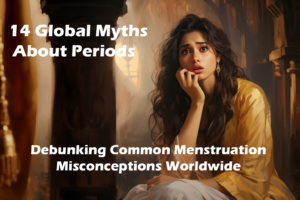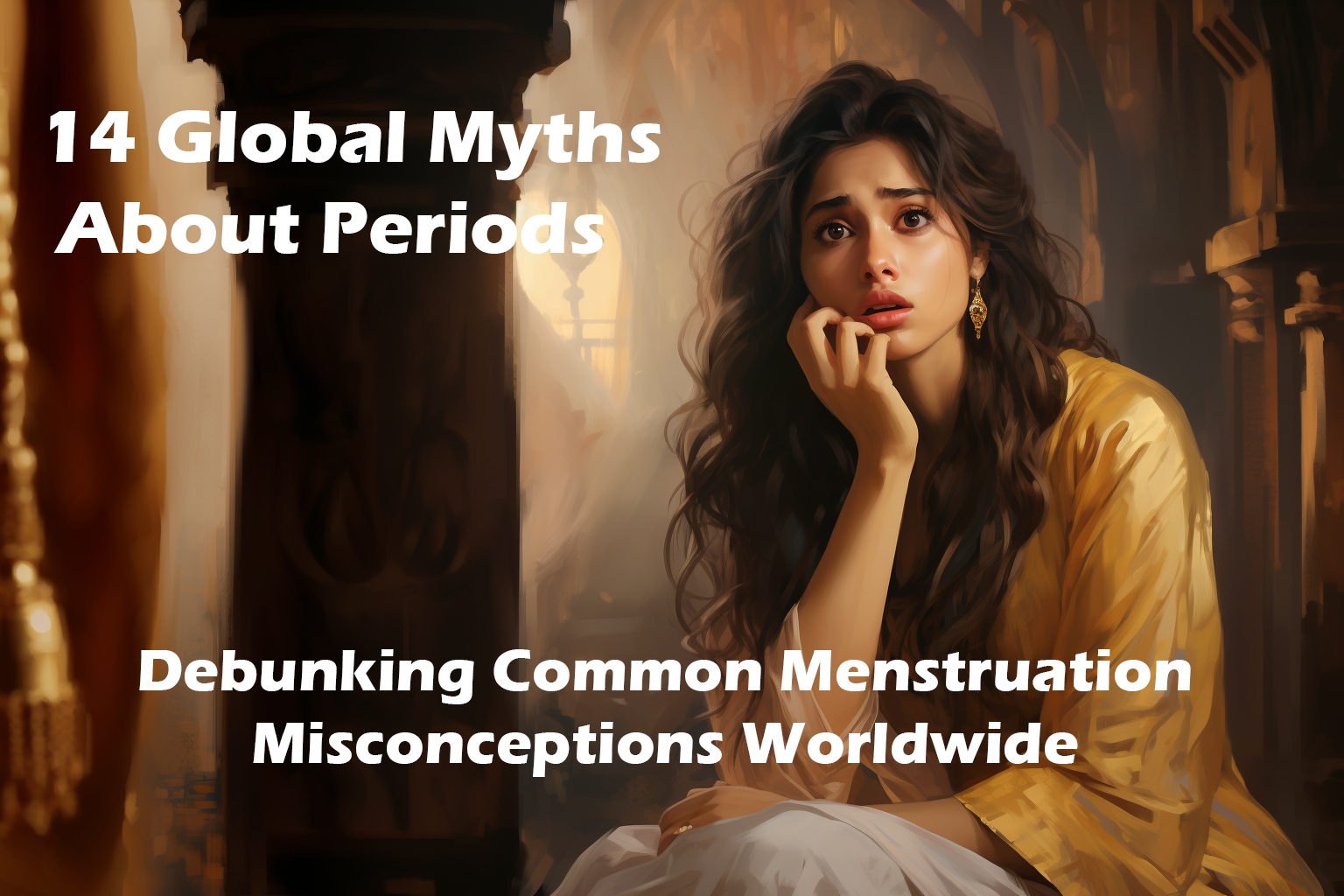Table of Contents
Menses after delivery (Postpartum Menstruation)
After childbirth, a woman’s body undergoes a myriad of changes as it transitions from the pregnant state back to its non-pregnant state. One of the most anticipated and sometimes anxiety-inducing changes is the return of menstruation. The postpartum period, which refers to the time following childbirth, is a unique phase in a woman’s life. It’s marked by physical recovery, emotional adjustments, and hormonal shifts. Among these changes, the return of the menstrual cycle stands out as a significant milestone.
For many women, the absence of menstruation during pregnancy is one of its perks. However, after delivery, there’s often curiosity and sometimes concern about when the menstrual cycle will resume, what it will be like, and how it might differ from pre-pregnancy periods. This article aims to shed light on these questions and provide comprehensive information on menses after delivery.
It’s essential to understand that every woman’s experience with postpartum menstruation can vary. Factors such as breastfeeding, individual hormonal responses, and overall health play a role in determining when and how menstruation returns. As we delve deeper into the subsequent chapters, we’ll explore the physiology behind postpartum menstruation, the impact of breastfeeding, and address common concerns and questions women often have during this transitional phase.
The Physiology Behind Postpartum Menstruation
The return of menstruation after childbirth is a complex process governed by hormonal and physical changes. To understand this process, it’s crucial to first grasp the hormonal landscape during pregnancy and immediately after delivery.
Hormonal Changes During Pregnancy:
During pregnancy, the body experiences elevated levels of hormones, especially progesterone and estrogen. These hormones play a vital role in maintaining the pregnancy by preventing ovulation and, consequently, menstruation. The placenta, which nourishes the fetus, produces human chorionic gonadotropin (hCG) and other hormones essential for fetal development.
Postpartum Hormonal Shifts:
Immediately after childbirth, the levels of pregnancy-related hormones drop significantly. The rapid decline in hormones like progesterone and estrogen triggers the body to start the process of returning to its non-pregnant state. As the uterus contracts and returns to its pre-pregnancy size, a process called involution, the body prepares for the eventual return of ovulation and menstruation.
Role of Prolactin and Breastfeeding:
Breastfeeding introduces another hormonal player into the mix: prolactin. Prolactin is the hormone responsible for milk production. High levels of prolactin, especially in women who are exclusively breastfeeding, can suppress ovulation, delaying the return of menstruation. However, it’s worth noting that while breastfeeding can delay menstruation, it’s not a foolproof method of contraception. Ovulation can occur before the return of menstruation, making it possible for a woman to conceive even if she hasn’t had her period yet.
The Return of Ovulation:
Before menstruation can return, ovulation must occur. In some women, ovulation can return as early as six weeks postpartum, while in others, especially those who are breastfeeding, it might take several months. The first postpartum period typically follows ovulation by about two weeks, though it’s possible for the first ovulation to not result in menstruation.
In conclusion, the return of menstruation after childbirth is a multifaceted process influenced by various hormonal and physical factors. The body’s journey to resuming its menstrual cycle is a testament to its incredible ability to adapt and recover after the monumental task of childbirth.
When to Expect Your First Period After Delivery
The return of menstruation after childbirth is a highly individualized experience, with timelines varying significantly among women. Several factors influence when a woman might get her first postpartum period. Let’s delve into these factors and provide a general guideline on what to expect.
1. Breastfeeding:
As mentioned in the previous chapter, breastfeeding plays a pivotal role in determining the return of menstruation. Women who exclusively breastfeed (meaning the baby receives no other form of nutrition) might find that their periods don’t return for several months. This delay is due to the high levels of the hormone prolactin, which suppresses ovulation. However, as the baby starts to consume other foods and the frequency of breastfeeding decreases, the chances of menstruation returning increase.
2. Individual Hormonal Responses:
Every woman’s body is unique, and so is her hormonal response after childbirth. Some women might experience the return of menstruation within a couple of months postpartum, even if they are breastfeeding, while others might not see their period for over a year.
3. Previous Menstrual History:
A woman’s menstrual history before pregnancy can provide some clues about when she might expect her period postpartum. Women who had regular cycles before pregnancy are more likely to return to a regular cycle postpartum, while those with irregular cycles might experience irregularities post-delivery as well.
4. Physical Health and Recovery:
The body’s physical recovery after childbirth can also influence the return of menstruation. Factors such as postpartum complications, infections, or significant blood loss during delivery can impact when menstruation returns.
5. Contraceptive Use:
Some women might start using contraceptives soon after delivery, especially if they’re not breastfeeding. Certain contraceptives, like the progesterone-only pill or hormonal IUDs, can influence the return of menstruation.
General Timelines:
Non-breastfeeding mothers: Most women who don’t breastfeed will see their period return between six to eight weeks postpartum.
Breastfeeding mothers: For those who exclusively breastfeed, the return of menstruation can vary widely. Some might get their period within a few months, while others might not menstruate until they wean their baby completely.
In conclusion, while there are general guidelines, it’s essential for women to listen to their bodies and seek medical advice if they have concerns about their postpartum menstrual cycle. Every woman’s journey is unique, and understanding the factors that influence the return of menstruation can provide some clarity during this transitional phase.
Breastfeeding and Its Impact on Menstruation
Breastfeeding is a natural and beneficial process for both the mother and the baby. Beyond providing essential nutrients to the newborn, breastfeeding has several implications for the mother’s health, including its impact on postpartum menstruation.
The Link Between Breastfeeding and Ovulation:
The act of breastfeeding releases the hormone prolactin. High levels of prolactin in the bloodstream suppress the release of the hormones responsible for ovulation. Without ovulation, menstruation doesn’t occur. This natural suppression is nature’s way of spacing out pregnancies, allowing the mother’s body to recover fully before conceiving again.
Exclusive vs. Partial Breastfeeding:
The frequency and exclusivity of breastfeeding play a significant role in determining when menstruation will return. Mothers who exclusively breastfeed, meaning the baby receives no other form of nutrition, are more likely to experience a delay in the return of their periods compared to those who mix-feed with formula or introduce solids earlier.
Lactational Amenorrhea Method (LAM):
The Lactational Amenorrhea Method (LAM) is a natural form of contraception based on the principle that exclusive breastfeeding can prevent ovulation. For LAM to be effective, three criteria must be met:
- The mother must be exclusively breastfeeding.
- The baby must be less than six months old.
- The mother hasn’t had her period since childbirth.
While LAM can be effective, it’s essential to note that its efficacy decreases as the baby starts to consume other foods or if the frequency of breastfeeding reduces.
Breastfeeding and Menstrual Irregularities:
When menstruation does return for breastfeeding mothers, it might be irregular initially. The hormonal interplay between prolactin and the hormones governing the menstrual cycle can lead to variations in cycle length, flow, and even symptoms like cramping.
Breastfeeding and Fertility:
A common misconception is that breastfeeding mothers cannot get pregnant. While breastfeeding can delay ovulation, it doesn’t prevent it entirely. It’s possible for a woman to ovulate and become pregnant before she even realizes her menstrual cycle has resumed. Therefore, if a breastfeeding mother wishes to avoid pregnancy, she should discuss contraceptive options with her healthcare provider.
In conclusion, breastfeeding has a profound impact on postpartum menstruation. The body’s natural response to nursing can delay the return of menstruation, offering a period of natural fertility suppression. However, as with all things related to the human body, individual experiences can vary, and it’s essential to be informed and consult with healthcare professionals as needed.
Differences Between Postpartum Bleeding and Menstruation
After childbirth, women experience bleeding known as lochia. This bleeding is a natural part of the postpartum recovery process and is not the same as menstruation. It’s essential for women to understand the differences between lochia and the return of their menstrual cycle to navigate the postpartum period effectively.
What is Lochia?
Lochia is the vaginal discharge that occurs after childbirth, consisting of blood, mucus, and uterine tissue. It’s the body’s way of expelling the extra blood and tissue that supported the baby during pregnancy. Lochia can last for several weeks postpartum.
Stages of Lochia:
Lochia Rubra: This is the initial stage of postpartum bleeding, lasting for about 3-5 days after delivery. The discharge is bright red and can be quite heavy, similar to a heavy menstrual period.
Lochia Serosa: Occurring around days 4-10 postpartum, the discharge becomes pinkish-brown and less heavy. It contains less blood and more mucus.
Lochia Alba: This final stage can last from days 10 up to 6 weeks postpartum. The discharge is whitish or yellowish and mainly consists of mucus.
Distinguishing Lochia from Menstruation:
Duration: Lochia can last for several weeks, whereas a menstrual period typically lasts between 3-7 days.
Consistency: Lochia goes through stages, transitioning from bright red to pinkish-brown, then to a whitish or yellowish discharge. Menstrual blood is usually more consistent in color throughout the period.
Accompanying Symptoms: Menstruation can be accompanied by symptoms like cramping, bloating, and mood swings. While some postpartum discomfort is normal, especially in the initial days after delivery, the symptoms associated with lochia and menstruation can differ.
Time Frame: Most women will not experience their first menstrual period until after the lochia has completely stopped. However, it’s worth noting that ovulation can occur before the first postpartum period, so it’s possible for a woman to become pregnant even if she hasn’t menstruated yet.
In conclusion, while both lochia and menstruation involve vaginal bleeding, they are distinct processes with different causes and characteristics. Understanding these differences can help women better manage their postpartum recovery and anticipate the return of their menstrual cycle.
Common Concerns: Irregularities and Heavy Flow
The postpartum period is a time of significant change and adjustment for a woman’s body. As menstruation resumes after childbirth, it’s not uncommon for women to notice differences in their menstrual cycle. These changes can sometimes be a source of concern or confusion. In this chapter, we’ll address some of the most common concerns related to postpartum menstruation.
1. Irregular Periods:
Many women report irregular menstrual cycles in the months following childbirth. The length, frequency, and flow can vary from one cycle to the next. These irregularities can be attributed to hormonal fluctuations as the body readjusts post-pregnancy. Breastfeeding can also influence the regularity of periods.
2. Heavier Flow:
It’s not uncommon for the first few postpartum periods to be heavier than what a woman might have experienced before pregnancy. The uterine lining, which sheds during menstruation, might be thicker in the initial cycles after childbirth. However, if heavy bleeding continues or is accompanied by large clots, it’s essential to seek medical advice.
3. More Painful Periods:
Some women experience more painful periods after childbirth. This increased pain can be due to the uterus contracting more forcefully to expel the thicker lining. For others, periods might become less painful postpartum. Every woman’s experience is unique.
4. Spotting Between Periods:
Occasional spotting between periods can occur as the menstrual cycle regulates itself. However, consistent spotting or bleeding between periods warrants a visit to a healthcare professional to rule out any underlying issues.
5. Absence of Periods:
While breastfeeding can delay the return of menstruation, if a woman is not breastfeeding and hasn’t seen her period return by six months postpartum, it’s a good idea to consult with a healthcare provider. Several factors, including hormonal imbalances or conditions like polycystic ovary syndrome (PCOS), can influence the return of menstruation.
In conclusion, while variations in the postpartum menstrual cycle are typical, it’s essential for women to be informed and attentive to their bodies. Understanding what’s normal and what warrants medical attention can provide peace of mind during this transitional phase. Always consult with a healthcare professional regarding any concerns related to postpartum menstruation.
Fertility and Ovulation After Childbirth
Fertility and ovulation after childbirth are topics of great interest and importance to many women. Whether a woman is hoping to expand her family soon or wishes to delay another pregnancy, understanding her fertility postpartum is crucial.
1. Ovulation Before Menstruation:
One of the most significant points to understand is that ovulation can occur before the first postpartum period. This means that a woman can become pregnant even if she hasn’t had her period after giving birth. The first ovulation postpartum will lead to menstruation if conception doesn’t occur. However, if conception happens, the period won’t return, and the woman might only realize she’s pregnant several weeks later.
2. Breastfeeding and Fertility:
As discussed in previous chapters, exclusive breastfeeding can suppress ovulation, acting as a natural form of birth spacing. However, it’s not a guaranteed method of contraception. As the frequency of breastfeeding decreases or if the baby starts consuming other foods, the likelihood of ovulation and, consequently, the possibility of conception increases.
3. Return of Regular Cycles:
While some women might return to regular menstrual cycles soon after childbirth, others might experience irregularities for several months. These irregularities can make it challenging to predict ovulation, especially for women tracking their cycles as a method of natural family planning.
4. Fertility Awareness Methods:
For women interested in tracking their fertility postpartum, several fertility awareness methods can help identify the fertile window. These methods involve monitoring signs like basal body temperature, cervical mucus, and cervical position. However, it’s essential to note that postpartum hormonal fluctuations can sometimes make these signs less predictable.
5. Contraception Postpartum:
For women who wish to delay or prevent another pregnancy postpartum, discussing contraceptive options with a healthcare provider is crucial. Options range from barrier methods like condoms to hormonal methods like birth control pills, patches, or intrauterine devices (IUDs). The choice of contraception should consider factors like breastfeeding, personal health considerations, and future family planning goals.
In conclusion, understanding fertility and ovulation after childbirth empowers women to make informed decisions about family planning. Whether hoping for another child soon or wishing to space out pregnancies, being aware of one’s fertility and having open discussions with healthcare providers can guide the journey.
Contraception Considerations Post-Delivery
Contraception is an essential consideration for many women post-delivery, especially for those who wish to space out their pregnancies or delay future pregnancies. The postpartum period presents unique challenges and considerations when it comes to choosing a contraceptive method. This chapter will explore the various contraceptive options suitable for postpartum women and the factors to consider when making a choice.
1. Barrier Methods:
Condoms: Male and female condoms are readily available and do not interfere with breastfeeding. They also provide protection against sexually transmitted infections (STIs).
Diaphragm: A diaphragm is a dome-shaped device placed inside the vagina to cover the cervix. If considering this method postpartum, it’s essential to get refitted as childbirth can change the size of the cervix.
2. Hormonal Methods:
Birth Control Pills: There are two main types of birth control pills – combined oral contraceptives (COCs) containing both estrogen and progestin, and progestin-only pills (POPs). While COCs are effective, they might reduce milk supply in breastfeeding mothers. POPs, often called ‘mini-pills,’ are more suitable for breastfeeding women.
Patch and Vaginal Ring: Both release a combination of estrogen and progestin. They might not be the first choice for breastfeeding mothers due to the potential impact on milk supply.
Depo-Provera: This is a progestin-only injection given every three months. It’s breastfeeding-friendly and can be started as early as six weeks postpartum.
3. Long-Acting Reversible Contraceptives (LARCs):
Intrauterine Device (IUD): IUDs are small devices inserted into the uterus. There are two types: copper IUDs (non-hormonal) and hormonal IUDs. Both types are effective and can be inserted soon after delivery.
Implant: The contraceptive implant is a small rod inserted under the skin of the upper arm. It releases progestin and can prevent pregnancy for up to three years.
4. Natural Methods:
Fertility Awareness-Based Methods: These methods involve tracking the menstrual cycle to identify fertile days. Given the potential irregularities in postpartum cycles, these methods require careful monitoring and might not be as reliable immediately after childbirth.
Lactational Amenorrhea Method (LAM): As discussed in previous chapters, exclusive breastfeeding can act as a natural contraceptive for up to six months postpartum.
5. Permanent Methods:
- Tubal Ligation: This surgical procedure involves sealing or cutting the fallopian tubes, preventing the egg from reaching the sperm. It’s a permanent method of contraception.
In conclusion, postpartum contraception is a personal choice that should consider individual health, breastfeeding status, and future family planning goals. It’s essential to have a discussion with a healthcare provider to choose the most suitable method.
Postpartum Hormonal Changes and Mood Swings
The postpartum period is often accompanied by a rollercoaster of emotions. From the joy and elation of welcoming a new baby to feelings of exhaustion and overwhelm, new mothers experience a wide range of emotions. One of the significant contributors to these mood swings is the hormonal changes that occur after childbirth.
1. Hormonal Fluctuations Post-Delivery:
Immediately after delivery, there’s a sharp decline in pregnancy hormones, including estrogen and progesterone. Additionally, the levels of other hormones produced by the thyroid gland and the pituitary gland can fluctuate, impacting mood and overall well-being.
2. The ‘Baby Blues’:
Many women experience what’s commonly referred to as the ‘baby blues’ in the first few weeks after childbirth. Symptoms can include mood swings, irritability, sadness, and feeling overwhelmed. These feelings are typically short-lived and resolve on their own. They are often attributed to the sudden drop in estrogen and progesterone levels post-delivery.
3. Postpartum Depression (PPD):
While the ‘baby blues’ are relatively common and mild, some women experience more severe and prolonged symptoms known as postpartum depression (PPD). PPD can manifest as intense sadness, anxiety, irritability, and difficulty bonding with the baby. While hormonal changes can contribute to PPD, other factors like previous mental health issues, lack of support, and stressful life events play a role. It’s essential to seek medical advice if symptoms of PPD are suspected.
4. Breastfeeding and Hormones:
Breastfeeding releases the hormone oxytocin, often referred to as the ‘love hormone.’ Oxytocin promotes bonding between the mother and baby and has a calming effect on the mother. However, the high levels of prolactin produced during breastfeeding can lower estrogen levels, potentially impacting mood.
5. Regulating Hormones and Mood:
Self-Care: Taking time for self-care, including rest, a balanced diet, and gentle exercise, can help regulate mood and hormones.
Seek Support: Talking to loved ones, joining support groups, or seeking therapy can provide emotional relief and coping strategies.
Medication: In some cases, medication might be prescribed to address hormonal imbalances or mood disorders.
In conclusion, the postpartum period is a time of significant hormonal and emotional changes. Understanding the link between hormones and mood can help women navigate this transitional phase with greater awareness and seek support when needed.
Diet and Nutrition for Healthy Menstruation Post-Delivery
Diet and nutrition play a pivotal role in a woman’s overall health, and this is especially true in the postpartum period. As menstruation resumes after childbirth, ensuring a balanced and nutritious diet can support a healthy menstrual cycle and address some of the common concerns women might have during this time.
1. Importance of Iron:
Menstruation involves the loss of blood, and with it, the body loses iron. Postpartum women, especially those who experienced significant blood loss during delivery, might already have reduced iron levels. Including iron-rich foods like lean meats, beans, lentils, and dark leafy greens can help replenish iron stores and prevent anemia.
2. Stay Hydrated:
Adequate hydration is essential for overall health and can also influence the menstrual cycle. Staying hydrated can help alleviate bloating and cramping associated with menstruation. Drinking plenty of water and including hydrating foods like fruits and vegetables in the diet is beneficial.
3. Omega-3 Fatty Acids:
Omega-3 fatty acids, found in fatty fish, flaxseeds, and walnuts, have anti-inflammatory properties. They can help reduce menstrual pain and support overall reproductive health.
4. Magnesium-Rich Foods:
Magnesium is a mineral that plays a role in muscle function. Including magnesium-rich foods like nuts, seeds, and whole grains can help alleviate menstrual cramps.
5. Limit Caffeine and Sugar:
Excessive caffeine and sugar can exacerbate symptoms like bloating, breast tenderness, and mood swings. While it’s okay to indulge occasionally, it’s a good idea to monitor and limit the intake of caffeinated beverages and sugary foods.
6. Fiber for Hormonal Balance:
Fiber helps regulate blood sugar levels and supports healthy digestion. It also plays a role in balancing hormones by aiding the elimination of excess estrogen from the body. Including fiber-rich foods like whole grains, fruits, and vegetables can support a healthy menstrual cycle.
7. Vitamins and Minerals:
Ensuring adequate intake of essential vitamins and minerals like vitamin B6, vitamin E, and zinc can support menstrual health. These nutrients can be found in a variety of foods, including poultry, nuts, seeds, and whole grains.
8. Probiotics for Gut Health:
A healthy gut can influence hormonal balance. Including probiotic-rich foods like yogurt, kefir, and fermented vegetables can support gut health and, in turn, menstrual health.
In conclusion, a balanced and nutritious diet is a cornerstone of menstrual health post-delivery. By including a variety of nutrient-rich foods and staying hydrated, women can support their bodies as they navigate the return of menstruation after childbirth.
Exercise and Physical Activity for Menstrual Health
Exercise and physical activity offer numerous health benefits, including positive effects on menstrual health. For postpartum women, reintroducing exercise can be both a means to regain physical strength and a way to navigate the changes in their menstrual cycle after childbirth.
1. Alleviating Menstrual Cramps:
Engaging in regular physical activity can help alleviate menstrual cramps. Exercise releases endorphins, which are natural painkillers. Activities like walking, cycling, or yoga can help reduce the intensity and duration of menstrual pain.
2. Regulating Irregular Cycles:
Exercise can help regulate irregular menstrual cycles by promoting a healthy balance of hormones. However, it’s essential to strike a balance. While moderate exercise can be beneficial, excessive physical activity can disrupt the menstrual cycle, especially if combined with inadequate nutrition.
3. Mood Regulation:
As discussed in previous chapters, the postpartum period can bring about mood swings and emotional changes. Regular exercise can help regulate mood by releasing endorphins and reducing stress levels. This can be particularly beneficial for women experiencing mood fluctuations with their menstrual cycle.
4. Postpartum Recovery:
Engaging in postpartum-specific exercises can help strengthen the pelvic floor muscles, improve posture, and enhance overall physical strength. This not only aids in postpartum recovery but also supports menstrual health.
5. Weight Management:
Maintaining a healthy weight postpartum can influence menstrual health. Regular physical activity, combined with a balanced diet, can help manage weight, which in turn can regulate menstrual cycles and reduce symptoms like bloating.
6. Recommendations for Postpartum Women:
Start Slowly: Especially after a cesarean section or any complications during delivery, it’s essential to reintroduce exercise gradually. Starting with gentle activities like walking or pelvic floor exercises can be beneficial.
Listen to Your Body: Every woman’s postpartum recovery is unique. It’s crucial to listen to your body and not push too hard too soon.
Stay Hydrated: Staying hydrated is especially important for breastfeeding mothers. Drink plenty of water before, during, and after exercise.
Consult a Healthcare Professional: Before starting any exercise regimen postpartum, it’s a good idea to consult with a healthcare professional or a physical therapist specializing in postpartum recovery.
In conclusion, exercise and physical activity can play a pivotal role in menstrual health post-delivery. By adopting a balanced approach and listening to their bodies, postpartum women can harness the benefits of exercise for both menstrual and overall health.
The Role of Stress in Postpartum Menstruation
The postpartum period, while filled with joy and love, can also be a time of significant stress for many women. From adjusting to the demands of a newborn to physical recovery from childbirth, new mothers face a myriad of challenges. Stress, both physical and emotional, can have a profound impact on menstrual health post-delivery.
1. Stress and Hormonal Imbalance:
Stress activates the body’s ‘fight or flight’ response, leading to the release of the stress hormone cortisol. Elevated cortisol levels can disrupt the delicate balance of reproductive hormones, potentially leading to irregular menstrual cycles, missed periods, or more painful periods.
2. Stress and Ovulation:
Chronic stress can delay or even suppress ovulation. Without ovulation, menstruation doesn’t occur. This is the body’s natural way of ensuring that reproduction doesn’t happen during times of extreme stress.
3. Physical vs. Emotional Stress:
Both physical stress, like sleep deprivation or inadequate nutrition, and emotional stress, like anxiety or depression, can impact menstrual health. The postpartum period can bring about both types of stress, making it essential for new mothers to prioritize self-care.
4. Breastfeeding and Stress:
While breastfeeding can delay the return of menstruation, stress can further impact this delay. High stress levels can reduce milk supply, and the hormonal interplay between stress hormones and prolactin (the hormone responsible for milk production) can influence the return of menstruation.
5. Managing Stress for Menstrual Health:
Self-Care: Taking time for self-care, whether it’s a relaxing bath, reading a book, or practicing meditation, can help reduce stress levels.
Physical Activity: As discussed in previous chapters, regular physical activity can help alleviate stress and support menstrual health.
Seek Support: Talking to loved ones, joining support groups, or seeking therapy can provide emotional relief and coping strategies.
Prioritize Sleep: While challenging with a newborn, getting adequate rest is crucial for managing stress and supporting overall health.
Mindfulness and Relaxation Techniques: Practices like deep breathing exercises, progressive muscle relaxation, and mindfulness meditation can help manage stress and its impact on menstrual health.
In conclusion, stress is an inevitable part of the postpartum period, but its impact on menstrual health can be managed. By recognizing the signs of stress and adopting strategies to cope, postpartum women can support their menstrual health and overall well-being during this transitional phase.
Seeking Medical Advice: When to Consult a Healthcare Professional
While many changes in postpartum menstruation are normal and expected, there are certain signs and symptoms that might indicate an underlying issue. Recognizing these signs and seeking timely medical advice can ensure optimal reproductive health and address any potential concerns.
1. Prolonged Heavy Bleeding:
While it’s normal for the first few postpartum periods to be heavier than usual, prolonged heavy bleeding or passing large clots can be a cause for concern. It might indicate conditions like uterine fibroids, polyps, or hormonal imbalances.
2. Severe Pain:
While some menstrual cramping is normal, severe pain that interferes with daily activities warrants a visit to a healthcare professional. Conditions like endometriosis or pelvic inflammatory disease can cause intense menstrual pain.
3. Irregular Cycles for an Extended Period:
While irregularities in the initial postpartum cycles are common, consistently irregular cycles for an extended period might indicate conditions like polycystic ovary syndrome (PCOS) or thyroid issues.
4. Absence of Menstruation:
If a woman is not breastfeeding and hasn’t seen her period return by six months postpartum, it’s a good idea to consult with a healthcare provider. Several factors, including hormonal imbalances, can influence the return of menstruation.
5. Spotting Between Periods:
Occasional spotting between periods can occur as the menstrual cycle regulates itself. However, consistent spotting or bleeding between periods warrants a visit to a healthcare professional to rule out any underlying issues.
6. Other Symptoms:
Symptoms like excessive bloating, breast tenderness, severe mood swings, or migraines associated with the menstrual cycle can be discussed with a healthcare provider to determine their cause and potential treatments.
7. Postpartum Check-up:
It’s essential for women to attend their postpartum check-up, typically scheduled six weeks after delivery. This appointment is an opportunity to discuss any concerns related to menstruation, contraception, and overall reproductive health.
In conclusion, while many changes in postpartum menstruation are a natural part of the body’s adjustment after childbirth, it’s essential to be attentive to any signs that might indicate an underlying issue. Open communication with healthcare professionals and timely consultations can ensure that any concerns are addressed and that women can navigate their postpartum menstrual health with confidence.
The Importance of Postpartum Support and Community
The postpartum period, often referred to as the ‘fourth trimester,’ is a time of immense change and adjustment. While the physical and hormonal changes are evident, the emotional and psychological shifts can be equally profound. Having a supportive community during this time can not only aid in navigating these changes but also positively impact menstrual health and overall well-being.
1. Emotional Well-being and Menstrual Health:
Emotional well-being is intrinsically linked to menstrual health. Feelings of isolation, overwhelm, or postpartum mood disorders can exacerbate menstrual symptoms or lead to irregularities in the cycle. A supportive community can provide emotional relief, reducing stress and its impact on menstruation.
2. Sharing Experiences:
Every woman’s postpartum journey is unique, but there are shared experiences that many can relate to. Discussing menstrual changes, concerns, or symptoms with other postpartum women can provide reassurance and a sense of belonging. Knowing that one is not alone in their experiences can be immensely comforting.
3. Practical Support:
From helping with baby care to providing meals or assisting with household chores, practical support from the community can reduce the physical and emotional burden on a new mother. This reduction in stress and increased rest can positively influence menstrual health.
4. Access to Resources:
A supportive community can be a valuable resource for information and guidance. Whether it’s recommendations for healthcare professionals, advice on managing menstrual symptoms, or sharing effective self-care practices, community knowledge can be invaluable.
5. Building Resilience:
The challenges of the postpartum period can be overwhelming. A supportive community can help build resilience, empowering women to face challenges with confidence and optimism. This positive mindset can, in turn, promote better menstrual health.
6. Virtual Communities:
In today’s digital age, support isn’t limited to physical communities. Online forums, social media groups, and virtual support groups can provide a platform for postpartum women to connect, share, and support each other, transcending geographical boundaries.
In conclusion, the importance of postpartum support and community cannot be overstated. As women navigate the myriad of changes after childbirth, including those related to menstruation, having a supportive community can make the journey smoother, more informed, and emotionally fulfilling.
Conclusion: Embracing the Postpartum Journey
The postpartum period is a transformative phase in a woman’s life. From the joy of welcoming a new life to the challenges of physical recovery and hormonal adjustments, it’s a journey filled with highs and lows. One of the significant aspects of this journey is the return of menstruation and the changes associated with it.
Understanding these changes, being informed, and seeking support when needed are crucial for navigating postpartum menstrual health. Every woman’s experience is unique, and there’s no ‘one-size-fits-all’ approach. However, some universal truths can guide this journey:
1. Knowledge is Empowering:
Being informed about what to expect regarding postpartum menstruation can alleviate concerns and provide a sense of control. Whether it’s understanding the difference between lochia and menstruation, the impact of breastfeeding on periods, or the signs that warrant medical advice, knowledge is empowering.
2. Self-Care is Essential:
The postpartum period demands a lot from a woman’s body and mind. Prioritizing self-care, whether it’s through a balanced diet, regular exercise, relaxation techniques, or seeking emotional support, can have a profound impact on menstrual health and overall well-being.
3. Seek Support:
Whether it’s from loved ones, healthcare professionals, or a broader community, seeking support can make the postpartum journey smoother. Sharing experiences, voicing concerns, and seeking advice can provide both practical and emotional relief.
4. Embrace the Changes:
The postpartum period is a time of change, and while some of these changes can be challenging, they are also a testament to the incredible strength and resilience of women. Embracing these changes, celebrating the milestones, and practicing acceptance can make the journey more fulfilling.
In conclusion, the return of menstruation after childbirth is just one aspect of the broader postpartum experience. By approaching it with understanding, compassion, and informed awareness, women can navigate this phase with confidence and grace, embracing the beauty and challenges of the postpartum journey.

15 Global Myths About Periods: Debunking Common Menstruation Misconceptions Worldwide
Exploring the diverse and often surprising myths about periods from cultures around the world. From beliefs about menstruating women being impure to myths about their impact on food and physical objects, this article delves deep into the origins, implications, and scientific truths behind these age-old tales. Discover how societal taboos have shaped perceptions and understand the importance of debunking these myths for a more informed and inclusive future.

Menses After Delivery : Everything You Need to Know
Navigating the complexities of menses after delivery can be challenging for many women. This comprehensive guide delves into the intricacies of postpartum menstruation, hormonal shifts, and the importance of support during this transitional phase. Whether you’re a new mother or seeking knowledge about the changes that come with childbirth, understanding menses after delivery is crucial for optimal postpartum care and well-being.

8 Facts to Know Before Taking Medicine to Delay Periods
Menstruation is a natural process that many individuals experience regularly. However, there are times when delaying a period becomes desirable, whether for medical reasons, personal preferences, or special occasions. This article delves into the intricacies of the menstrual cycle, reasons for delaying periods, common medicine to delay periods, and the potential side effects and precautions to consider. Additionally, it explores natural methods that offer an alternative to medications. Whether you’re considering delaying your period or simply seeking knowledge, this article provides comprehensive insights into the topic

Ultimate Guide to Period Panties: Comfort during Menstruation
Period panties, also known as menstrual underwear, are a sustainable alternative to disposable menstrual products. They are designed to be leak-proof and absorbent, allowing women to comfortably manage their menstruation without the use of pads, tampons, or cups. These underwear come in various styles and absorbency levels to cater to different needs throughout the menstrual cycle.

Why Periods Delay- 10 reasons to understand
Understanding “why periods delay” is crucial for individuals navigating their reproductive health. From hormonal imbalances and stress to chronic diseases and lifestyle choices, various factors can influence menstrual regularity. This comprehensive article delves deep into the myriad reasons behind delayed periods, offering insights and guidance on recognizing irregularities and seeking timely medical advice. Whether you’re curious about the impact of weight fluctuations, the role of thyroid issues, or the effects of certain medications, this article provides a holistic overview of the factors that can affect menstrual cycles
Are you a victim of Period Cramps – Get updated in 5 Minutes
Navigating the world of period cramps can feel like a daunting journey. With throbbing pains and aching discomfort, they seem to bring a monthly trial for many. But do we really understand what’s happening? In this comprehensive guide, we unpack the science behind period cramps, delve into their causes, explore associated symptoms, and discuss various treatment options. We also look into prevention strategies, and highlight the psychological impact these monthly visitors can have. Whether you’re seeking knowledge or comfort, our guide on ‘All About Period Cramps’ is here to support you. Let’s make this journey together, understanding and managing period cramps, one step at a time.




